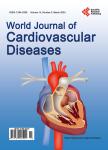Determining factors for carotid mean/max intima-media thickness and brachial flow-mediated dilation in healthy young women
Determining factors for carotid mean/max intima-media thickness and brachial flow-mediated dilation in healthy young women作者机构:Division of Cardiovascular Medicine Yao Municipal Hospital Yao Japan
出 版 物:《World Journal of Cardiovascular Diseases》 (心血管病(英文))
年 卷 期:2012年第2卷第2期
页 面:43-49页
学科分类:1002[医学-临床医学] 100201[医学-内科学(含:心血管病、血液病、呼吸系病、消化系病、内分泌与代谢病、肾病、风湿病、传染病)] 10[医学]
主 题:Intima-Media Thickness Flow-Mediated Dilation Young Women
摘 要:Background: Many factors can contribute to atherosclerotic-type vascular changes in older individuals or men. Thus, confining the investigation to young women with no clinical evidence of the condition could enhance understanding of the early stages of cardiovascular disease. The aim of this study was to determine whether carotid mean/max intima-media thickness (IMT) and brachial flow-mediated dilation (FMD) values, which are well-known event-related indices, are associated with laboratory data and the other vascular indices of atherosclerosis in healthy young women. Methods: Carotid mean/max IMT and brachial FMD were measured in young women with no clinical evidence of atherosclerosis (n = 110;mean age, 39 years) who were instructed not to eat, drink or smoke after 9 PM the evening before testing. All participants also underwent laboratory assessment, including simultaneous measurements of arterial stiffness such as augmentation index (AI), cardioankle vascular index (CAVI) and brachial-ankle pulse wave velocity (baPWV). Results: Mean IMT was signifi-cantly and positively associated with age (p = 0.002), CAVI (p = 0.044), low-density lipoprotein-cholesterol (LDL-C, p = 0.047) and high-sensitive C-reactive protein (hs-CRP, p = 0.002) values but was not related to FMD, AI, baPWV or triglycerides (TG) in the multivariate regression analysis. Similarly, max IMT was positively associated with age (p p = 0.003) and hs-CRP (p = 0.005) values but was not related to FMD, AI, CAVI, baPWV, TG or blood pressure level in the multivariate regression analysis. The association between LDL-C and max IMT was much stronger than that between LDL-C and mean IMT. Brachial FMD was positively associated only with heart rate in the multivariate regression analysis. Conclusions: These results suggest that mean IMT more closely represents the sclerotic aspect of vascular change, whereas max IMT represents the atherotic aspect in healthy young women. Although the relationship between the auto



